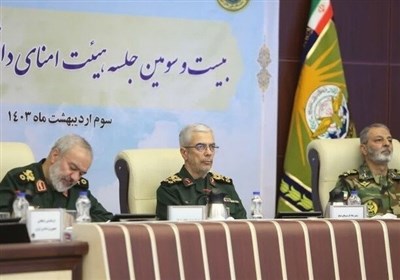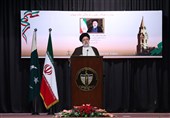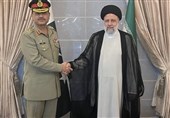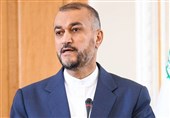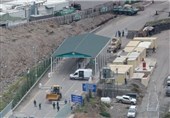Wahhabi Ideology behind Shiite Genocide in Saudi Town: US Analyst
TEHRAN (Tasnim) – An American political analyst described the extremist Wahhabi ideology dominant in Saudi Arabia as a driving force behind the killings of Shiites in the kingdom's besieged town of Awamiyah in the Qatif region.
“The Wahhabi ideology is very convenient for the Saudis because while the Saudi regime is primarily motivated by geopolitical concerns, and expanding its own political influence in the region, the Wahhabi ideology creates a pretext for these massacres of the Shiite people in Yemen and Qatif,” Keith Preston, the chief editor and director of attackthesystem.com, told the Tasnim news agency.
Keith Preston was born in Lynchburg, Virginia, United States. He received degrees in Religious Studies, History, and Sociology from Virginia Commonwealth University. He is the founder and director of American Revolutionary Vanguard and the chief editor of AttacktheSystem.Com. He has also been a contributor to LewRockwell.Com, Antiwar.Com, Anti-State.Com,Taki’s Magazine, Radix Journal, and AlternativeRight.Com . He is the author of six books, and was awarded the 2008 Chris R. Tame Memorial Prize by the United Kingdom’s Libertarian Alliance. Keith has been a featured speaker at conferences of the National Policy Institute, H. L. Mencken Club, and Anarchapulco. He has been interviewed on numerous radio programs and internet broadcasts, and appeared as a guest analyst on Russia Today, Press TV and the BBC.
Following is the full text of the interview.
Tasnim: As you know Saudi military bulldozers have almost razed Awamiyah to the ground amid the deadly crackdown on the besieged Shiite town, forcing hundreds of its residents to flee their homes. The Middle East Eye news portal cited activists as saying that authorities have resorted to compulsory evictions in and around the historic al-Mosara district of Awamyiah. What's the aim of the systematic Shiite killings?
Preston: What they are doing in Awamiyah is the same thing they are doing in Yemen. It is all part of the same plan. Saudi Arabia is making war on Iran by means of committing genocide against Shiite people in both Saudi Arabia and Yemen. The reasons for the massacres of the Shiite people in Yemen and Qatif are clear enough. This is a systemic genocide that is being carried out for the purpose of eradicating the Shiite population there. Two principal motivations on the part of the Saudi forces are behind these actions. The first of these motivations is the hostility of the Saudis, and their regional allies and collaborators within Yemen, to Iran and their fear that the Shiites will be used by Iran as a means of expanding Iranian influence in Yemen and on their own soil. The Saudis wish to prevent Yemen from coming under the Iranian sphere of influence. These actions have their roots not only in the ongoing conflict between Saudi Arabia and Iran, but also in wider geopolitical conflicts on the global level. Iran, like Syria, is a nation that resists being incorporated into the Washington Consensus and seeks to modernize and develop its own society. However, the Saudis and their regional allies are also among Washington’s staunchest allies. The Houthi rebellion led the Saudis to fear that a pro-Iranian Yemen that also rejects the Washington Consensus might emerge. The ambition of the Saudis is to eliminate the Shiites in Yemen and Qatif in order to remove any possibility of pro-Iranian sentiment developing any further in Saudi Arabia and Yemen. The second motivation is religious in the sense that the Wahhabi interpretation of Sunni Islam is not only dominant in Saudi Arabia, it is the state religion, and has a particularly powerful presence in the Saudi armed forces. The Wahhabists regard the Shiite people as apostates, heretics, or infidels and consequently seek to annihilate them.
Tasnim: How much do you think the Wahhabi ideology is behind this genocide?
Preston: The Wahhabi ideology is very convenient for the Saudis because while the Saudi regime is primarily motivated by geopolitical concerns, and expanding its own political influence in the region, the Wahhabi ideology creates a pretext for these massacres of the Shiite people in Yemen and Qatif. The political objectives of the Saudi state are bolstered by the religious hatred felt by the Wahhabists against the Shiites. It is consequently easy for the Saudi regime to incite its armed forces motivated by religious hatred of the Shiites to carry out these atrocities. The Saudi regime is using the hatred that its fanatical Wahhabist armed forces feel for the Shiites as a means of motivating its armed forces to carry out a genocide that the Saudis wish to use to advance their geopolitical objectives.
Tasnim: The latest developments in the Shiite-populated city came after a transition of power and after the new crown prince Mohammed Bin Salman took the helm of power in the Arabian Peninsula country. What do you think? Kindly explain.
Preston: Mohammed Bin Salman has taken a particularly hawkish position on matters pertaining to Saudi Arabia’s foreign and domestic policy objectives, particularly the war in Yemen and the relationship between Saudi Arabia and Iran. Therefore, it is not surprising that attacks on the Shiites in Yemen and Awamiyah would escalate immediately following Mohammed Bin Salman’s ascension to power as the new crown prince. Many observers of Saudi Arabia are confused concerning why Mohammed Bin Salman would take steps to seemingly liberalize Saudi Arabia internally, to the consternation of Saudi Arabia’s Wahhabist clerics, while escalating the war in Yemen at the same time and using the Wahhabist ideology as a means fueling genocide of the Shiites. But a closer inspection shows that this is no contradiction. Both sets of actions are consistent with Mohammed Bin Salman’s efforts to solidify the relationship between Saudi Arabia and the United States while opposing and undermining forces that resist the Washington Consensus in the Middle East. Both the economic and social changes that Mohammed Bin Salman has proposed or moved towards is representative of an effort on his part to embrace the neoliberal paradigm that Washington wishes to impose on the region, and that Mohammed Bin Salman wishes for Saudi Arabia to further embrace as well.
Notice that the escalated attacks on the Shiites and the domestic reform proposals announced by Mohammed Bin Salman are coming not only after his ascension to power but after the recent arms deal between Saudi Arabia and the United States. All of these factors are converging at the same time. The House of Saud has installed a younger crown prince that wishes to implement domestic changes that move Saudi Arabia further towards the neoliberal economic model and Western cultural model favored by the United States. The installation of Mohammed Bin Salman came approximately one month after the visit of US President Trump to Saudi Arabia and the development of the $110bn arms deal between the two nations. And now the escalation of the attacks on Yemen and Qatif are coming only a short time after Mohammed Bin Salman’s installation. These attacks on the Shiites are being used to advance not only the objectives of the Saudis but also those of the United States as both nations wish to prevent Yemen from becoming part of the Resistance Block, or what they consider to be a "rouge state,” i.e. one that rejects the Washington Consensus. Therefore, it is not contradictory that Mohammed Bin Salman would offend Wahhabist clerics by proposing reforms in Saudi Arabia domestically while at the same time using the Wahhabist ideology as a weapon in the war against Yemen, and as a means of inciting genocide against the Shiites.

